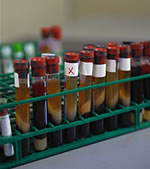- A recently-discovered biomarker, JAK2, was used to confirm 33 cases
of PV.
- The confirmed cases had no common occupations, ancestry, lifestyle choices or exposures.
- The cancer registry did not accurately reflect the true number of PV cases in the area.
- In some areas, the PV rates were higher than the rest of the tri-county area, however, only one of these areas was statistically significant.
- There were potential environmental exposure sources common to some
of the high-rate areas.
- It is not known whether a relationship exists between any of these sources and the PV cases. This investigation was not designed to study such relationships.
- Further, the cause of PV is unknown; hence, it is difficult to link the illness to any environmental agent or any other factor.
- More research is needed to understand the reasons for the high rate of PV in this area.
- ATSDR and PADOH organized a meeting of PV experts to identify and discuss future research activities. This Expert Panel met on August 25, 2008, in Philadelphia, PA, and will make their recommendations public in late September, 2008.
- PADOH will continue to monitor PV occurrence.
- The Centers for Disease Control and Prevention will continue to evaluate state and national registry reporting systems for PV and other diseases.

Background
Polycythemia vera (PV) - PV is a rare illness that causes the body to make too many red blood cells. The most common symptoms of PV are blood clots, heart attacks and strokes. PV has no known cause. A few studies, published more than 25 years ago, reported that PV could possibly be caused by exposure to chemicals (benzene, embalming fluid, petroleum products) or radiation.
In 2004, a change (mutation) in a gene called JAK2 was found to occur in most PV patients. This mutation is not inherited and causes bone marrow cells to constantly make red blood cells – even when the body signals them to stop. This discovery has now led scientists to search for the cause of the JAK2 mutation in hopes that this knowledge will help them find the cause of PV.
ATSDR Investigation
In October 2006, the Pennsylvania Department of Health requested ATSDR’s help in investigating a high number of PV cases reported in Carbon, Luzerne, and Schuylkill counties. ATSDR was asked to make sure that the reported cases actually had PV, and to find any other cases of PV in the tri-county area. A survey of the possible cases was conducted to collect information on work and residence histories, health status, and other factors that might be related to PV. ATSDR’s field work began in November 2006, and was completed in July 2007. In October 2007, ATSDR held a community meeting in Hazleton, Pennsylvania to discuss its findings. ATSDR issued a news release summarizing the findings. On August 25, 2008, ATSDR presented the final results of the investigation to the public.
ATSDR’s conclusions were:
Future Work
Selected Resources for the Reader
NEW! Polycythemia Vera Expert Panel Meeting Preliminary Research Proposals - October 10, 2008 [PDF, 28 KB]
An Investigation of
Polycythemia Vera in the Tamaqua Area of Northeast Pennsylvania:
Final Report [PDF, 114KB] |
Report Figures [PDF, 205KB]
Polycythemia Vera Incidence in the Tamaqua Area of Pennsylvania - Community Slide Presentation [PDF, 1841KB]
Polycythemia Vera (review article in American Family Physician)![]()
1-800-CDC-INFO, or e-mail


